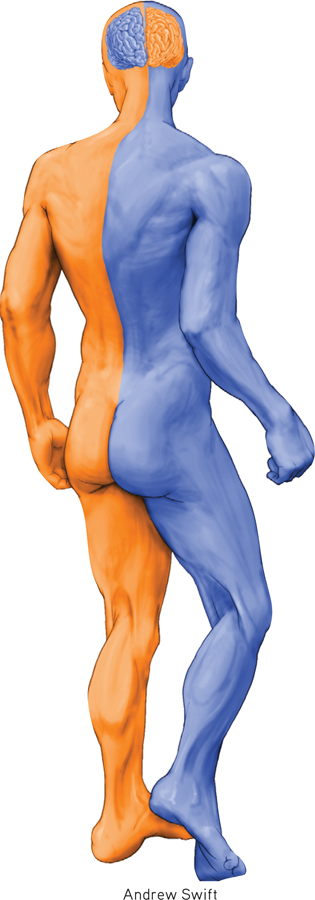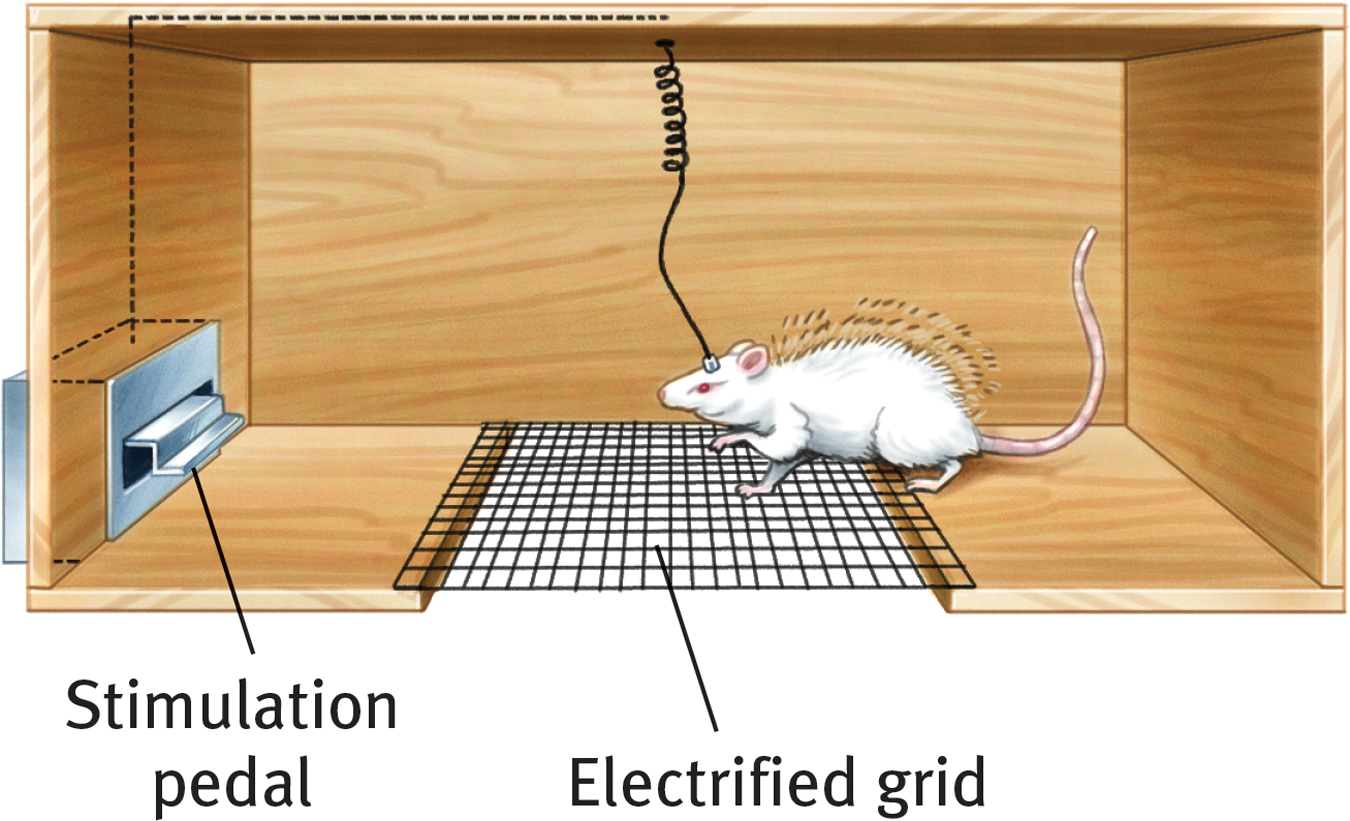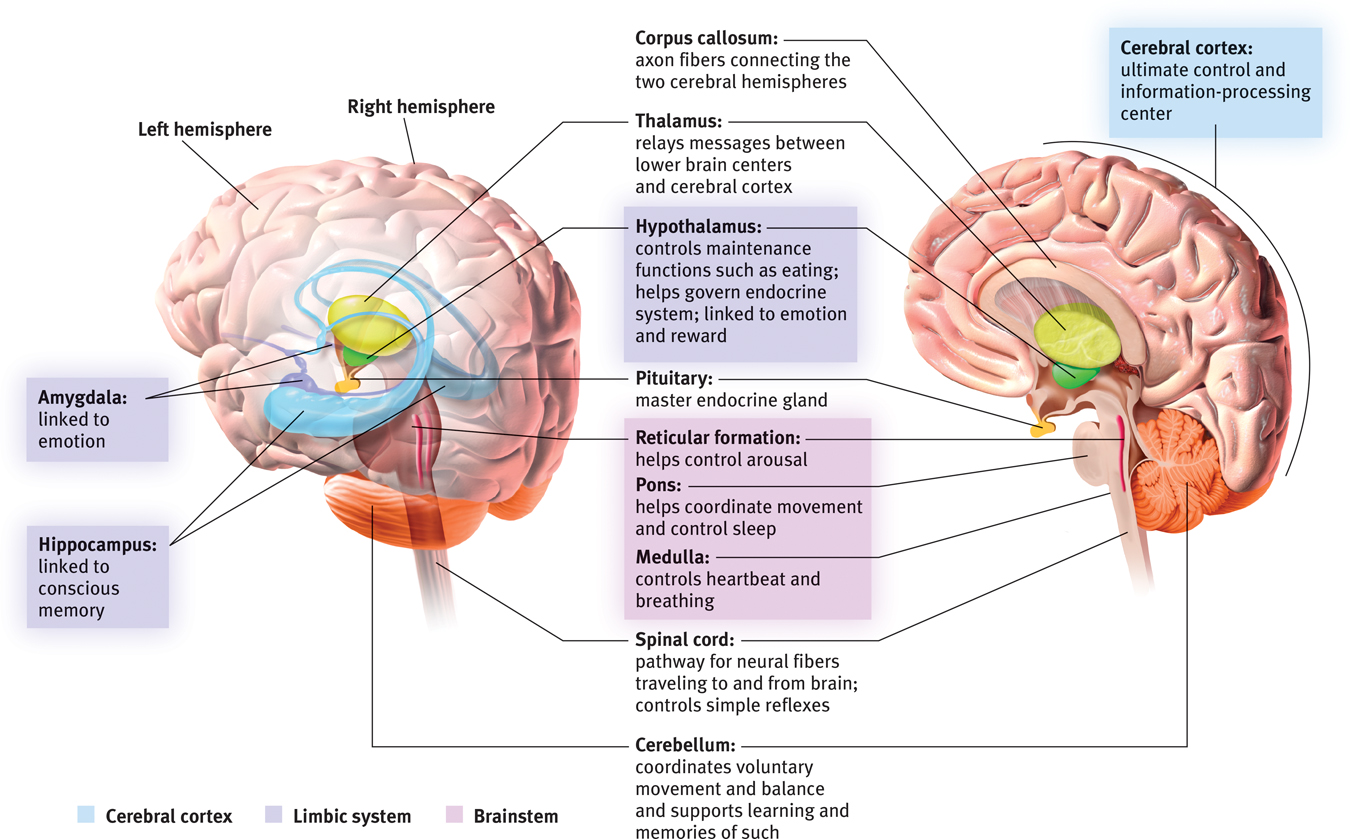6.2 Older Brain Structures

6-
An animal’s capacities come from its brain structures. In primitive animals, such as sharks, a not-
This increasing complexity arises from new brain systems built on top of the old, much as the Earth’s landscape covers the old with the new. Digging down, one discovers the fossil remnants of the past—
 For an introductory 12.5-minute overview of the brain, visit LaunchPad’s Video: The Central Nervous System—Spotlight on the Brain.
For an introductory 12.5-minute overview of the brain, visit LaunchPad’s Video: The Central Nervous System—Spotlight on the Brain.
The Brainstem
The brain’s oldest and innermost region is the brainstem. It begins where the spinal cord swells slightly after entering the skull. This slight swelling is the medulla (FIGURE 6.4). Here lie the controls for your heartbeat and breathing. As some brain-

 Figure 6.4
Figure 6.4The brainstem and thalamus The brainstem, including the pons and medulla, is an extension of the spinal cord. The thalamus is attached to the top of the brainstem. The reticular formation passes through both structures.
If a cat’s brainstem is severed from the rest of the brain above it, the animal will still breathe and live—
The brainstem is a crossover point, where most nerves to and from each side of the brain connect with the body’s opposite side (FIGURE 6.5). This peculiar cross-
RETRIEVAL PRACTICE

 Figure 6.5
Figure 6.5The body’s wiring
- Nerves from the left side of the brain are mostly linked to the ___________ side of the body, and vice versa.
right
70
The Thalamus
Sitting atop the brainstem is the thalamus, a pair of egg-
The Reticular Formation
Inside the brainstem, between your ears, lies the reticular (“net-
In 1949, Giuseppe Moruzzi and Horace Magoun discovered that electrically stimulating a sleeping cat’s reticular formation almost instantly produced an awake, alert animal. When Magoun severed a cat’s reticular formation without damaging nearby sensory pathways, the effect was equally dramatic: The cat lapsed into a coma from which it never awakened. The conclusion? The reticular formation enables arousal.
The Cerebellum
Extending from the rear of the brainstem is the baseball-

 Figure 6.6
Figure 6.6The brain’s organ of agility Hanging at the back of the brain, the cerebellum coordinates our voluntary movements.
***
Note: These older brain functions all occur without any conscious effort. This illustrates another of our recurring themes: Our brain processes most information outside of our awareness. We are aware of the results of our brain’s labor (say, our current visual experience) but not of the how. Likewise, whether we are asleep or awake, our brainstem manages its life-
 To review and check your understanding, visit LaunchPad’s Concept Practice: Lower Brain Structures.
To review and check your understanding, visit LaunchPad’s Concept Practice: Lower Brain Structures.
RETRIEVAL PRACTICE
- In what brain region would damage be most likely to (1) disrupt your ability to skip rope? (2) disrupt your ability to hear and taste? (3) perhaps leave you in a coma? (4) cut off the very breath and heartbeat of life?
1. cerebellum, 2. thalamus, 3. reticular formation, 4. medulla
71
The Limbic System
6-
We’ve now considered the brain’s oldest parts. Its newest and highest regions are the cerebral hemispheres (the two halves of the brain). Between the oldest and newest brain areas lies the limbic system (limbus means “border”). This system contains the amygdala, the hypothalamus, and the hippocampus (FIGURE 6.7). The hippocampus process conscious, explicit memories. Animals or humans who lose their hippocampus to surgery or injury also lose their ability to form new memories of facts and events. Other modules explain how our two-

 Figure 6.7
Figure 6.7The limbic system This neural system sits between the brain’s older parts and its cerebral hemispheres. The limbic system’s hypothalamus controls the nearby pituitary gland.
The AmygdalaResearch has linked the amygdala, two lima-

What then might happen if we electrically stimulated the amygdala of a placid domestic animal, such as a cat? Do so in one spot and the cat prepares to attack, hissing with its back arched, its pupils dilated, its hair on end. Move the electrode only slightly within the amygdala, cage the cat with a small mouse, and now it cowers in terror.
These and other experiments have confirmed the amygdala’s role in fear and rage. One study found math anxiety associated with hyperactivity in the right amygdala (Young et al., 2012). Other studies have shown people angry and happy faces: The amygdala activates in response to the angry ones (Mende-
RETRIEVAL PRACTICE
- Electrical stimulation of a cat’s amygdala provokes angry reactions. Which autonomic nervous system division is activated by such stimulation?
The sympathetic nervous system
The HypothalamusJust below (hypo) the thalamus is the hypothalamus (FIGURE 6.8), an important link in the command chain governing bodily maintenance. Some neural clusters in the hypothalamus influence hunger; others regulate thirst, body temperature, and sexual behavior. Together, they help maintain a steady (homeostatic) internal state.

 Figure 6.8
Figure 6.8The hypothalamus This small but important structure, colored yellow/orange in this MRI-
As the hypothalamus monitors the state of your body, it tunes into your blood chemistry and any incoming orders from other brain parts. For example, picking up signals from your brain’s cerebral cortex that you are thinking about sex, your hypothalamus will secrete hormones. These hormones will in turn trigger the adjacent “master gland” of the endocrine system, your pituitary (see Figure 6.7), to influence your sex glands to release their hormones. These will intensify the thoughts of sex in your cerebral cortex. (Note the interplay between the nervous and endocrine systems: The brain influences the endocrine system, which in turn influences the brain.)
72
A remarkable discovery about the hypothalamus illustrates how progress in science often occurs—
In a meticulous series of experiments, Olds (1958) went on to locate other “pleasure centers,” as he called them. (What the rats actually experience only they know, and they aren’t telling. Rather than attribute human feelings to rats, today’s scientists refer to reward centers, not “pleasure centers.”) When allowed to press pedals to trigger their own stimulation, rats would sometimes do so more than 1000 times per hour. Moreover, they would even cross an electrified floor that a starving rat would not cross to reach food (FIGURE 6.9).

 Figure 6.9
Figure 6.9Rat with an implanted electrode With an electrode implanted in a reward center of its hypothalamus, the rat readily crosses an electrified grid, accepting the painful shocks, to press a pedal that sends electrical impulses to that center.
In other species, including dolphins and monkeys, researchers later discovered other limbic system reward centers, such as the nucleus accumbens in front of the hypothalamus. Animal research has also revealed both a general dopamine-
Researchers are experimenting with new ways of using brain stimulation to control animals’ actions in search-

 Figure 6.10
Figure 6.10Ratbot on a pleasure cruise Researchers used a remote control brain stimulator to guide rats across a field and even up a tree.
Do humans have limbic centers for pleasure? To calm violent patients, one neurosurgeon implanted electrodes in such areas. Stimulated patients reported mild pleasure; unlike Olds’ rats, however, they were not driven to a frenzy (Deutsch, 1972; Hooper & Teresi, 1986). Moreover, newer research reveals that stimulating the brain’s “hedonic hotspots” (its reward circuits) produces more desire than pure enjoyment (Kringelbach & Berridge, 2012). Experiments have also revealed the effects of a dopamine-
73
“If you were designing a robot vehicle to walk into the future and survive, … you’d wire it up so that behavior that ensured the survival of the self or the species—like sex and eating—would be naturally reinforcing.”
Candace Pert (1986)
Some researchers believe that addictive disorders, such as substance use disorders and binge eating, may stem from malfunctions in natural brain systems for pleasure and well-
***
FIGURE 6.11 locates the brain areas we’ve discussed, as well as the next module’s focus, the cerebral cortex.

 Figure 6.11
Figure 6.11Brain structures and their functions
 To review and assess your understanding, visit LaunchPad’s Concept Practice: The Limbic System.
To review and assess your understanding, visit LaunchPad’s Concept Practice: The Limbic System.
RETRIEVAL PRACTICE
- What are the three key structures of the limbic system, and what functions do they serve?
(1) The amygdala is involved in aggression and fear responses. (2) The hypothalamus is involved in bodily maintenance, pleasurable rewards, and control of the hormonal systems. (3) The hippocampus processes conscious memory.